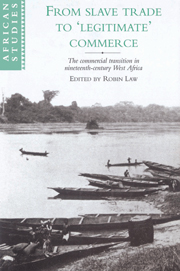 From Slave Trade to 'Legitimate' Commerce
From Slave Trade to 'Legitimate' Commerce Book contents
- Frontmatter
- Contents
- List of contributors
- List of abbreviations
- Introduction
- 1 The initial ‘crisis of adaptation’: the impact of British abolition on the Atlantic slave trade in West Africa, 1808–1820
- 2 The West African palm oil trade in the nineteenth century and the ‘crisis of adaptation’
- 3 The compatibility of the slave and palm oil trades in Dahomey, 1818–1858
- 4 Between abolition and Jihad: the Asante response to the ending of the Atlantic slave trade, 1807–1896
- 5 Plantations and labour in the south-east Gold Coast from the late eighteenth to the mid nineteenth century
- 6 Owners, slaves and the struggle for labour in the commercial transition at Lagos
- 7 Slaves, Igbo women and palm oil in the nineteenth century
- 8 ‘Legitimate’ trade and gender relations in Yorubaland and Dahomey
- 9 In search of a desert-edge perspective: the Sahara-Sahel and the Atlantic trade, c. 1815–1900
- 10 The ‘New International Economic Order’ in the nineteenth century: Britain's first Development Plan for Africa
- Appendix The ‘crisis of adaptation’: a bibliography
- Index
5 - Plantations and labour in the south-east Gold Coast from the late eighteenth to the mid nineteenth century
Published online by Cambridge University Press: 21 September 2009
- Frontmatter
- Contents
- List of contributors
- List of abbreviations
- Introduction
- 1 The initial ‘crisis of adaptation’: the impact of British abolition on the Atlantic slave trade in West Africa, 1808–1820
- 2 The West African palm oil trade in the nineteenth century and the ‘crisis of adaptation’
- 3 The compatibility of the slave and palm oil trades in Dahomey, 1818–1858
- 4 Between abolition and Jihad: the Asante response to the ending of the Atlantic slave trade, 1807–1896
- 5 Plantations and labour in the south-east Gold Coast from the late eighteenth to the mid nineteenth century
- 6 Owners, slaves and the struggle for labour in the commercial transition at Lagos
- 7 Slaves, Igbo women and palm oil in the nineteenth century
- 8 ‘Legitimate’ trade and gender relations in Yorubaland and Dahomey
- 9 In search of a desert-edge perspective: the Sahara-Sahel and the Atlantic trade, c. 1815–1900
- 10 The ‘New International Economic Order’ in the nineteenth century: Britain's first Development Plan for Africa
- Appendix The ‘crisis of adaptation’: a bibliography
- Index
Summary
Trade cannot flourish without colonization and the cultivation of colonial produce.
That there was a complex historical relationship between the abolition of the trans-Atlantic slave trade and legitimate commerce has been widely and lengthily debated among Africanists and others. The debate is virtually contemporaneous with the abolition of the external slave trade itself. A fundamental issue has been to determine the precise nature of the impact of abolition on West African social and political formations. According to Tony Hopkins, the European powers' decision to abolish the external slave trade created for West Africa ‘the problem of developing alternative exports’. He continues: ‘The outcome was a period of transition and experimentation, which is customarily referred to as the era of “legitimate commerce” in order to distinguish it from the illegal trade in slaves'. Hopkins argued that ‘the structure of legitimate trade marked an important break with the past and signified a new phase in the growth of the market, a phase which can be seen as the start of the modern economic history of West Africa’, and constituted a ‘crisis of adaptation’. Others have interpreted the commercial transition in less sweeping terms, suggesting that there was no decisive rupture with the past, and hence by implication no ‘crisis of adaptation’.
Immanuel Wallerstein, too, sees a continuity. His historical context is an expanding capitalist world-system and the (structural) incorporation of West Africa into it.
- Type
- Chapter
- Information
- From Slave Trade to 'Legitimate' CommerceThe Commercial Transition in Nineteenth-Century West Africa, pp. 119 - 143Publisher: Cambridge University PressPrint publication year: 1995
- 5
- Cited by
